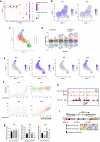Unique expression and critical role of metallothionein 3 in the control of osteoclastogenesis and osteoporosis
- PMID: 39085359
- PMCID: PMC11372110
- DOI: 10.1038/s12276-024-01290-3
Unique expression and critical role of metallothionein 3 in the control of osteoclastogenesis and osteoporosis
Abstract
Bone homeostasis is maintained by an intricate balance between osteoclasts and osteoblasts, which becomes disturbed in osteoporosis. Metallothioneins (MTs) are major contributors in cellular zinc regulation. However, the role of MTs in bone cell regulation has remained unexplored. Single-cell RNA sequencing analysis discovered that, unlike the expression of other MT members, the expression of MT3 was unique to osteoclasts among various macrophage populations and was highly upregulated during osteoclast differentiation. This unique MT3 upregulation was validated experimentally and supported by ATAC sequencing data analyses. Downregulation of MT3 by gene knockdown or knockout resulted in excessive osteoclastogenesis and exacerbated bone loss in ovariectomy-induced osteoporosis. Transcriptome sequencing of MT3 knockdown osteoclasts and gene set enrichment analysis indicated that the oxidative stress and redox pathways were enriched, which was verified by MT3-dependent regulation of reactive oxygen species (ROS). In addition, MT3 deficiency increased the transcriptional activity of SP1 in a manner dependent on intracellular zinc levels. This MT3-zinc-SP1 axis was crucial for the control of osteoclasts, as zinc chelation and SP1 knockdown abrogated the promotion of SP1 activity and osteoclastogenesis by MT3 deletion. Moreover, SP1 bound to the NFATc1 promoter, and overexpression of an inactive SP1 mutant negated the effects of MT3 deletion on NFATc1 and osteoclastogenesis. In conclusion, MT3 plays a pivotal role in controlling osteoclastogenesis and bone metabolism via dual axes involving ROS and SP1. The present study demonstrated that MT3 elevation is a potential therapeutic strategy for osteolytic bone disorders, and it established for the first time that MT3 is a crucial bone mass regulator.
© 2024. The Author(s).
Conflict of interest statement
The authors declare no competing interests.
Figures








References
-
- Hadjidakis, D. J. & Androulakis, I. I. Bone remodeling. Ann. NY Acad. Sci.1092, 385–396 (2006). - PubMed
-
- Veis, D. J. & O’Brien, C. A. Osteoclasts, master sculptors of bone. Annu. Rev. Pathol.18, 257–281 (2023). - PubMed
-
- Cummings, S. R. & Melton, L. J. Epidemiology and outcomes of osteoporotic fractures. Lancet359, 1761–1767 (2002). - PubMed
-
- Melton, L. J. 3rd Who has osteoporosis? A conflict between clinical and public health perspectives. J. Bone Min. Res. 15, 2309–2314 (2000). - PubMed
-
- Reid, I. R. & Billington, E. O. Drug therapy for osteoporosis in older adults. Lancet399, 1080–1092 (2022). - PubMed
MeSH terms
Substances
Grants and funding
LinkOut - more resources
Full Text Sources
Medical
Miscellaneous

